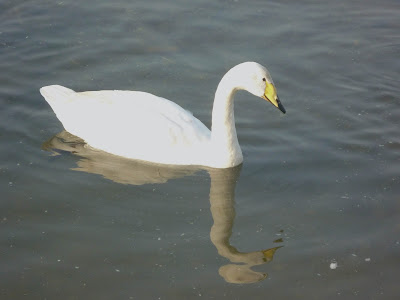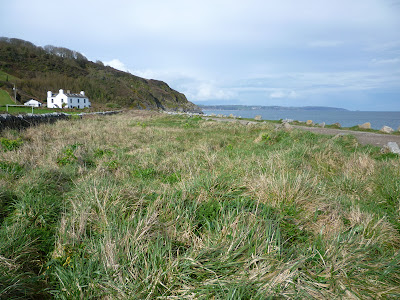I was feeling a bit 'twitchy' so decided it must be time for another expedition. It was a toss up between the Long-billed Dowitcher in the Somerset Levels or the Night Heron in Woolacombe. The Night Heron won, so yesterday we headed to North Devon. Back on 13th March, 4 were reported, 3 adults & a 'first-summer', although the numbers have dwindled to the 'first-summer' & occasionally 1 adult.
We followed the directions on Birdguides & parked in the lay-by at the entrance to the Woolacombe Sands Holiday Park, and followed the footpath signs down the road to the stables. The road was so steep that poor old Vera had trouble controlling her decent, but she made it down to the more gently sloping footpath beyond the stables without crashing. The private garden with the pond runs parallel to the footpath & can be seen through a hedge. I started peering through the foliage in search of the Heron, but then went round a bend to find a couple with bins looking in the garden. They had seen it walking on the bank & go down into the reeds, which was lucky as it was pretty hard to spot where it was. The pressure was off! Number 145 was in the bag. Now I could just enjoy having a nice long look.
 |
| The best photo I could manage |
We'd started chatting to the couple that had found it, Jill & Peter, 2 ex-DBWPS members who were on holiday in Woolacombe. It was a bit of a 'birdy' conversation (not-surprisingly) & Simon looked a bit blank & explained that he was just the 'driver & bodyguard' (bodyguard following our encounter on the Devon Bird Atlas survey). I found the Heron in the scope & Simon had a look..... "it looks a bit like pheasant", he said. At this point Peter & Jill looked aghast, "you weren't kidding about being the driver!" said Peter. Ok, we could only see bits of it through the vegetation, but a pheasant? I whipped out my Collins & showed him what he was looking at. Although Birdguides had described it as a 'first summer' bird, the one in the scope was clearly a Juvenile according to Collins, with large white spots on its feathers.
We watched it for about an hour; most of the time it was motionless, standing at the bottom of the grass bank at the water's edge waiting for lunch. It moved along a few feet a couple of times, once briefly going onto the top of the bank. It caught a small fish, and something bigger that took a while to get down, but we couldn't see what. Meanwhile we were chatting away to Jill & Peter, a very friendly couple.
A few people walked past whilst we were there. "What are you looking at" asked one chap. "A Night Heron, its' quite rare" I informed him. "I won't even pretend to know what one is" he said, "it's a bit like a pheasant" replied Peter.
 |
| "It looks a bit like a pheasant" |
By now it was lunchtime, so we went into Woolacombe & parked up for lunch with a nice view of the beach before heading off to Braunton Burrows. I'd never even heard of it before, but saw it on the map & thought we'd give it a go. I'm glad we did, it was an amazing place. It's a vast area of sand dunes, 1300 hectares to be precise, one of the most important dune systems in Europe & the biggest in the UK. It fills a 1 1/2 km band between the 6km long Saunton Beach & the marshes behind. Nearly 500 species of wildflower have been recorded in the dunes, along with 33 species of butterfly, helping to make Braunton the most biodiverse parish in England (or so the bumf claims anyway!").
We started off with a walk on the beach, not a bird in sight, but Vera enjoyed a paddle.
 |
| Vera enjoys a paddle on Saunton beach |
Simon & V then 'did there own thing' while I went off for a wander in the dunes with my bins.
 |
| d-uuuuuuuuuuuuuuuuuuuuunes |
I heard Skylarks, Wrens, & Robins and saw a Stonechat, Buzzard & Crow. I had a bit of a mystery bird which I recorded (on my iphone, worked surprisingly well) & photographed (at a distance, silhouetted) but still can't identify for sure.
There were a few shacks nestled in the dunes looking like
something from the American South, but minus the banjo playing hillbilly.
 |
| A set from Deliverance? |
Spring was in the air with a few Bumble Bees at work in the
scrub. Unfortunately at least one of them was carrying extra passengers in the
form of mites, although they didn’t appear to be effecting its ability to
fly.
 |
| Bumble-bee (sp Bombus locorum..I think) with mites. Nasty! |
It's obviously a bit early to see the variety of flowers that live in the dunes, but I did find a couple of interesting plants. I would probably struggle to identify them if they were in flower, but with no flowers I have no hope! Still, they looked good!
 |
| This one had a tiny reservoir of water at the centre |
 |
| Hairy or what! |
I may not have found many birds but it was a really interesting place to visit & I'll hopefully go back there later in the Spring.




















































